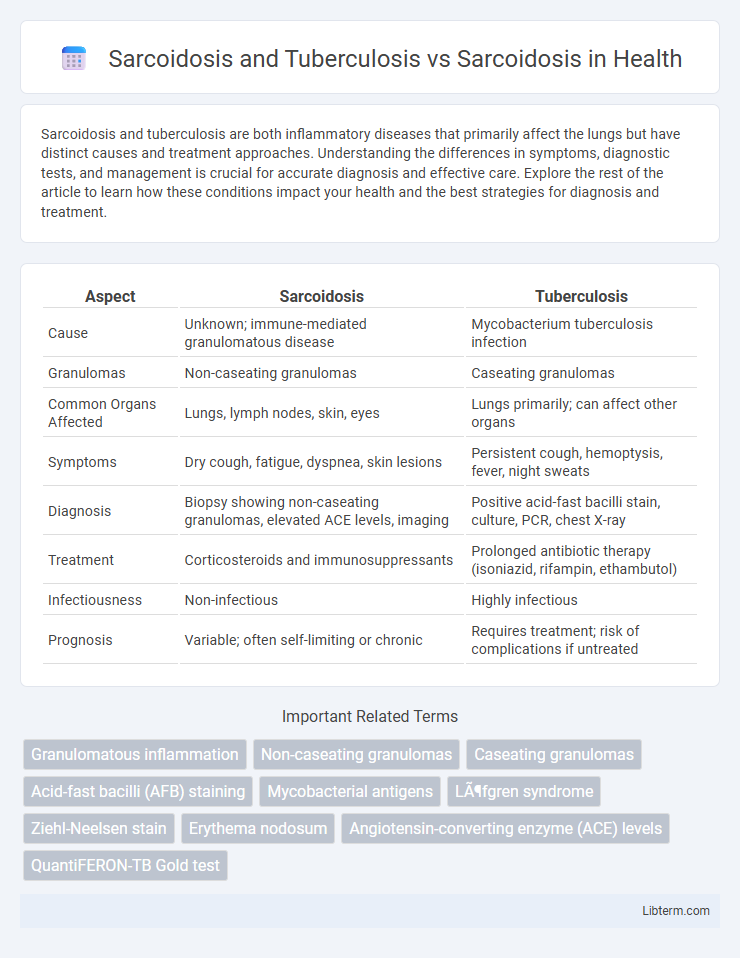Sarcoidosis and tuberculosis are both inflammatory diseases that primarily affect the lungs but have distinct causes and treatment approaches. Understanding the differences in symptoms, diagnostic tests, and management is crucial for accurate diagnosis and effective care. Explore the rest of the article to learn how these conditions impact your health and the best strategies for diagnosis and treatment.
Table of Comparison
| Aspect | Sarcoidosis | Tuberculosis |
|---|---|---|
| Cause | Unknown; immune-mediated granulomatous disease | Mycobacterium tuberculosis infection |
| Granulomas | Non-caseating granulomas | Caseating granulomas |
| Common Organs Affected | Lungs, lymph nodes, skin, eyes | Lungs primarily; can affect other organs |
| Symptoms | Dry cough, fatigue, dyspnea, skin lesions | Persistent cough, hemoptysis, fever, night sweats |
| Diagnosis | Biopsy showing non-caseating granulomas, elevated ACE levels, imaging | Positive acid-fast bacilli stain, culture, PCR, chest X-ray |
| Treatment | Corticosteroids and immunosuppressants | Prolonged antibiotic therapy (isoniazid, rifampin, ethambutol) |
| Infectiousness | Non-infectious | Highly infectious |
| Prognosis | Variable; often self-limiting or chronic | Requires treatment; risk of complications if untreated |
Understanding Sarcoidosis: An Overview
Sarcoidosis is a multi-system inflammatory disease characterized by non-caseating granulomas, primarily affecting the lungs, skin, and lymph nodes, distinguishable from tuberculosis, which involves caseating granulomas due to Mycobacterium tuberculosis infection. Diagnostic differentiation relies on clinical presentation, imaging, histopathological examination, and microbiological tests to exclude tuberculosis or other infections. Understanding sarcoidosis requires focusing on its idiopathic origin, immunopathogenesis involving T-cell activation, and variable clinical manifestations to guide appropriate management and avoid mistreatment.
Tuberculosis: Causes, Symptoms, and Diagnosis
Tuberculosis, caused by the bacterium Mycobacterium tuberculosis, primarily affects the lungs but can target other organs, presenting symptoms such as persistent cough, fever, night sweats, and weight loss, which can overlap with sarcoidosis manifestations. Accurate diagnosis relies on identifying acid-fast bacilli through sputum smear microscopy, culture tests, and molecular assays like PCR to distinguish tuberculosis from sarcoidosis, which is characterized by non-caseating granulomas without infection. Understanding these differences is critical for effective treatment, as tuberculosis requires prolonged antibiotic therapy, while sarcoidosis often responds to corticosteroids.
Sarcoidosis vs Tuberculosis: Key Differences
Sarcoidosis and tuberculosis are granulomatous diseases primarily affecting the lungs, but sarcoidosis typically involves non-caseating granulomas, whereas tuberculosis is characterized by caseating granulomas caused by Mycobacterium tuberculosis infection. Sarcoidosis often presents with bilateral hilar lymphadenopathy and erythema nodosum, while tuberculosis exhibits symptoms such as chronic cough, hemoptysis, and night sweats. Diagnostic differentiation relies on histopathological examination, acid-fast bacilli staining, and interferon-gamma release assays, which help distinguish sarcoidosis's immune-mediated inflammation from the infectious etiology of tuberculosis.
Pathophysiology: Sarcoidosis and Tuberculosis Compared
Sarcoidosis is characterized by non-caseating granulomas caused by an exaggerated immune response to unknown antigens, leading to multisystem inflammation primarily in the lungs and lymphatic system. Tuberculosis results from Mycobacterium tuberculosis infection, producing caseating granulomas due to a chronic immune response and tissue necrosis. The distinction in granuloma type--non-caseating in sarcoidosis versus caseating in tuberculosis--reflects underlying differences in pathophysiology and guides differential diagnosis and treatment strategies.
Clinical Manifestations: Overlapping and Distinct Signs
Sarcoidosis and tuberculosis share overlapping clinical manifestations such as persistent cough, fatigue, and bilateral hilar lymphadenopathy, making differential diagnosis challenging. Sarcoidosis often presents with non-caseating granulomas on biopsy, while tuberculosis is characterized by caseating granulomas and positive Mycobacterium tuberculosis cultures. Distinct signs include erythema nodosum and uveitis predominantly in sarcoidosis, whereas night sweats, weight loss, and hemoptysis are more common in tuberculosis.
Diagnostic Challenges: Differentiating Sarcoidosis from Tuberculosis
Differentiating sarcoidosis from tuberculosis presents significant diagnostic challenges due to overlapping clinical, radiological, and histopathological features such as granuloma formation. Tuberculosis typically shows caseating granulomas with positive acid-fast bacilli on Ziehl-Neelsen staining, whereas sarcoidosis features non-caseating granulomas without detectable mycobacteria. Advanced diagnostic methods like PCR for Mycobacterium tuberculosis DNA and interferon-gamma release assays (IGRAs) assist in distinguishing the two conditions for appropriate treatment strategies.
Radiological Differences in Sarcoidosis and Tuberculosis
Sarcoidosis typically presents with bilateral hilar lymphadenopathy and perilymphatic micronodules primarily involving the upper and middle lung zones on chest X-rays and high-resolution CT scans. Tuberculosis often shows unilateral or asymmetric lymphadenopathy with caseating necrosis, cavitary lesions, and centrilobular nodules predominantly in the apical and posterior segments of the upper lobes. Unlike tuberculosis, sarcoidosis rarely exhibits cavitation or consolidation, aiding differential diagnosis through radiological imaging features.
Laboratory and Histopathology Findings
Sarcoidosis typically shows non-caseating granulomas with multinucleated giant cells on histopathology, whereas tuberculosis presents with caseating granulomas and acid-fast bacilli detectable by Ziehl-Neelsen staining. Laboratory findings in sarcoidosis often include elevated serum angiotensin-converting enzyme (ACE) levels and hypercalcemia, while tuberculosis is diagnosed through positive sputum culture or PCR for Mycobacterium tuberculosis. Both diseases may show granulomatous inflammation, but the presence of caseation necrosis and Mycobacterium tuberculosis confirms tuberculosis over sarcoidosis.
Treatment Approaches: Sarcoidosis versus Tuberculosis
Treatment approaches for sarcoidosis primarily involve corticosteroids to reduce inflammation and suppress immune activity, while tuberculosis requires prolonged antibiotic therapy using drugs such as isoniazid, rifampin, ethambutol, and pyrazinamide. Sarcoidosis management focuses on controlling symptoms and preventing organ damage without targeting infection, whereas tuberculosis treatment aims to eradicate Mycobacterium tuberculosis and prevent drug resistance. Close monitoring is essential in both conditions to adjust therapy duration and address potential complications like fibrosis or drug toxicity.
Prognosis and Outcomes: What to Expect
Sarcoidosis typically has a variable prognosis with many patients experiencing spontaneous remission, while tuberculosis (TB) prognosis heavily depends on timely diagnosis and adequate antibiotic treatment to prevent complications. Chronic sarcoidosis may lead to organ damage such as pulmonary fibrosis, whereas untreated TB can result in severe lung destruction and systemic spread. Both diseases require ongoing monitoring, but TB outcomes improve significantly with appropriate therapy, contrasting with sarcoidosis, where treatment efficacy varies and long-term outcomes depend on organ involvement and response.
Sarcoidosis and Tuberculosis Infographic

 libterm.com
libterm.com